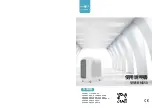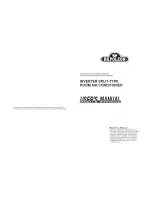
English
17
•
If the check operation was not performed at first istallation, the malfunc-
tion code “U3” will be displayed in the remote controller. Perform the
check operation following
“11-2-2 Procedure of Check Operation
.
13-3 Checks After Test Run
Perform the following checks after the test run is complete.
•
Record the contents of field setting.
→
Record them on the accessory “REQUEST FOR THE INDICA-
TION” label.
And attach the label on the back side of the front panel.
•
Record the installation date.
→
Record the installation date on the accessory “REQUEST FOR
THE INDICATION” label in accordance with the IEC60335-2-40.
And attach the label on the back side of the front panel.
NOTE
After the test run, when handing the unit over to the customer, make
sure the EL.COMPO.BOX lid, the inspection door, and the unit casing
are all attached.
14. CAUTION FOR REFRIGERANT LEAKS
(Points to note in connection with refrigerant leaks)
Introduction
The installer and system specialist shall secure safety against
leakage according to local regulations or standards. The following
standards may be applicable if local regulations are not available.
The VRV System, like other air conditioning systems, uses R410A as
refrigerant. R410A itself is an entirely safe non-toxic, non-combustible
refrigerant. Nevertheless care must be taken to ensure that air condi-
tioning facilities are installed in a room which is sufficiently large. This
assures that the maximum concentration level of refrigerant gas is not
exceeded, in the unlikely event of major leak in the system and this in
accordance to the local applicable regulations and standards.
Maximum concentration level
The maximum charge of refrigerant and the calculation of the maximum
concentration of refrigerant is directly related to the humanly occupied
space in to which it could leak.
The unit of measurement of the concentration is lb/ft
3
( the weight in lb
of the refrigerant gas in 1 ft
3
volume of the occupied space).
Compliance to the local applicable regulations and standards for the
maximum allowable concentration level is required.
1.
direction of the refrigerant flow
2.
room where refrigerant leak has occurred (outflow of all the
refrigerant from the system)
Pay a special attention to the place, such as a basement, etc.
where refrigerant can stay, since refrigerant is heavier than air.
Procedure for checking maximum concentration
Check the maximum concentration level in accordance with steps 1 to 4
below and take whatever action is necessary to comply.
1.
Calculate the amount of refrigerant (lb) charged to each system sep-
arately.
NOTE
•
Where a single refrigerant facility is divided into 2 entirely indepen-
dent refrigerant systems then use the amount of refrigerant with
which each separate system is charged.
2.
Calculate the smallest room volume (ft
3
)
Incase like the following, calculate the volume of (A), (B) as a single
room or as the smallest room.
A.
Where there are no smaller room divisions
B.
Where there is a room division but there is an opening
between the rooms sufficiently large to permit a free flow of air
back and forth.
1.
opening between rooms
2.
partition
(Where there is an opening without a door or where there are openings
above and below the door which are each equivalent in size to 0.15% or
more of the floor area.)
3.
Calculating the refrigerant density using the results of the calcula-
tions in steps 1 and 2 above.
If the result of the above calculation exceeds the maximum concen-
tration level then make similar calculations for the second then third
smallest room and so until the result falls short of the maximum con-
centration.
4.
Dealing with the situations where the result exceeds the maximum
concentration level.
Where the installation of a facility results in a concentration in excess
of the maximum concentration level then it will be necessary to
revise the system. Please consult your Daikin supplier.
2
1
amount of refriger-
ant in a single unit
system (amount of
refrigerant with
which the system
is charged before
leaving the factory)
+
additional charging
amount (amount of
refrigerant added
locally in accordance
with the length or
diameter of the refrig-
erant piping)
=
total amount
of refrigerant
(lb) in the
system
total volume of refrigerant in the
refrigerant system
≤
maximum concen-
tration level (lb/ft
3
)
size (ft
3
) of smallest room in which
there is an indoor unit installed
1
2


































